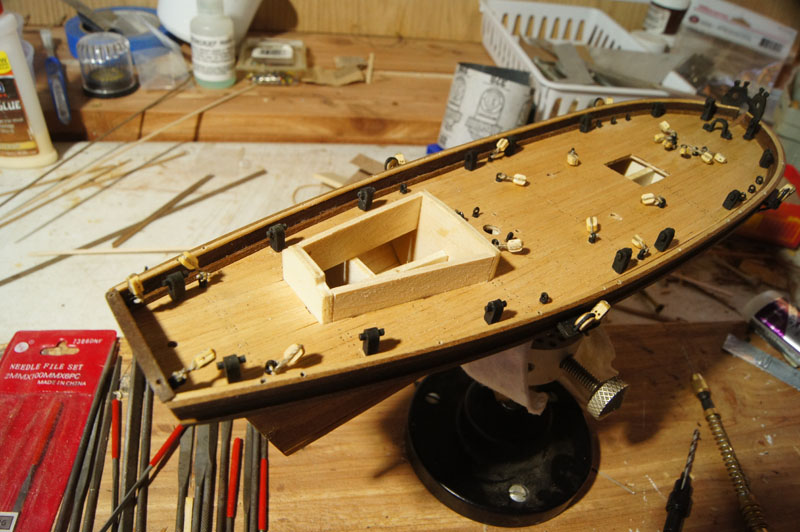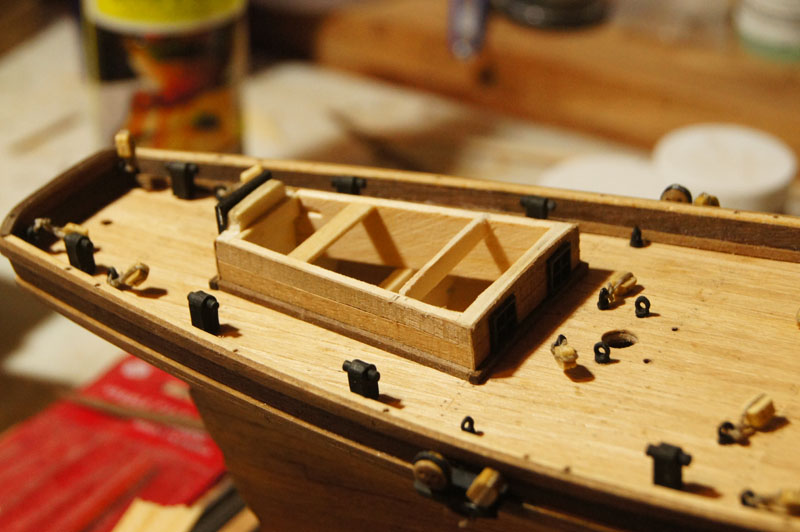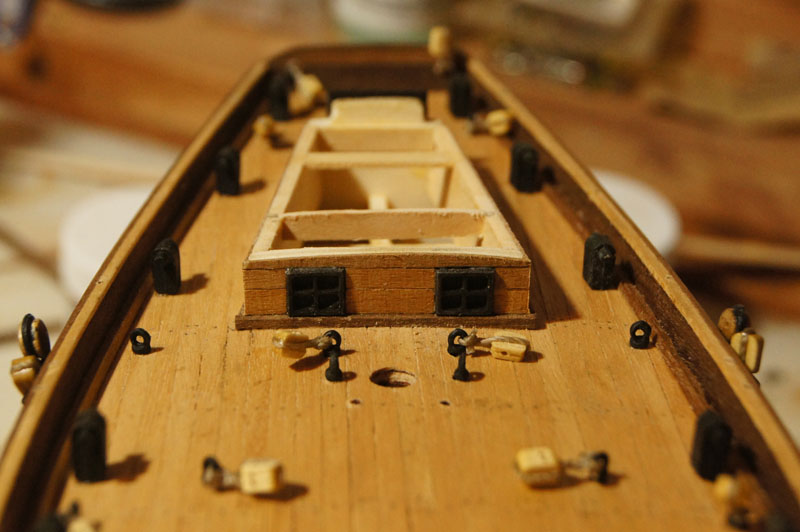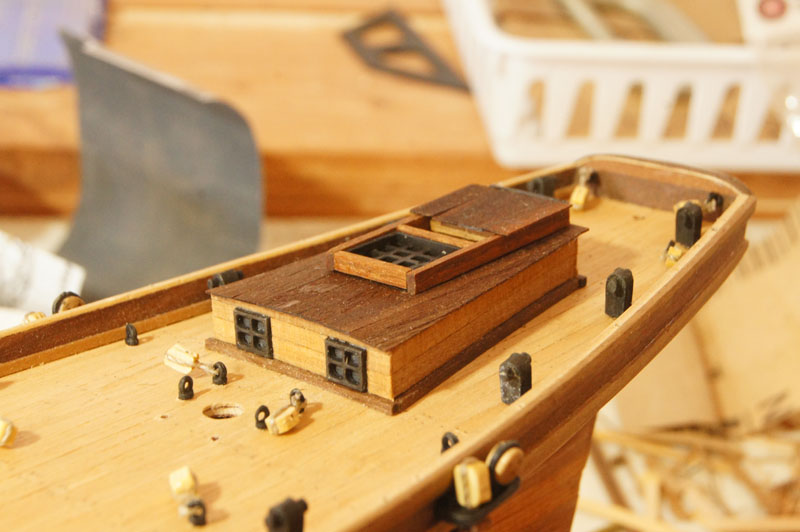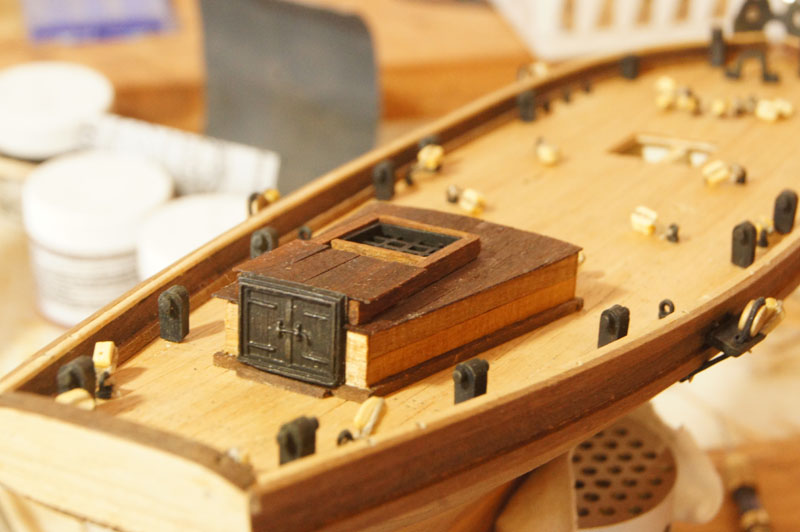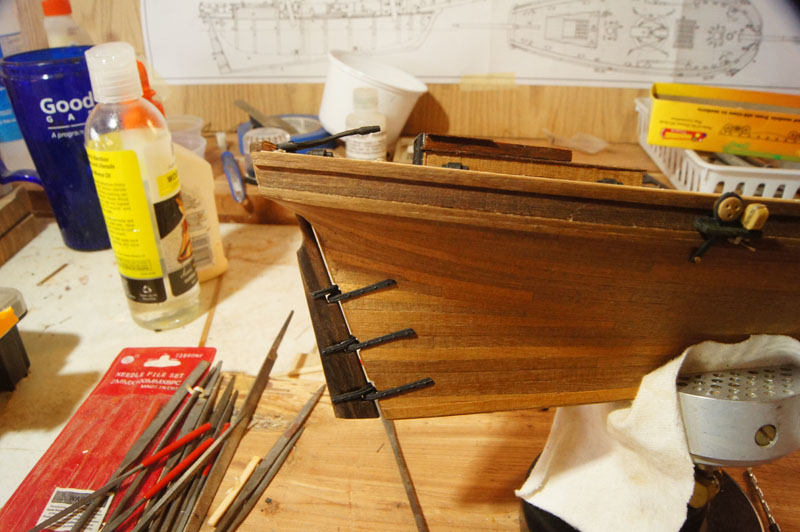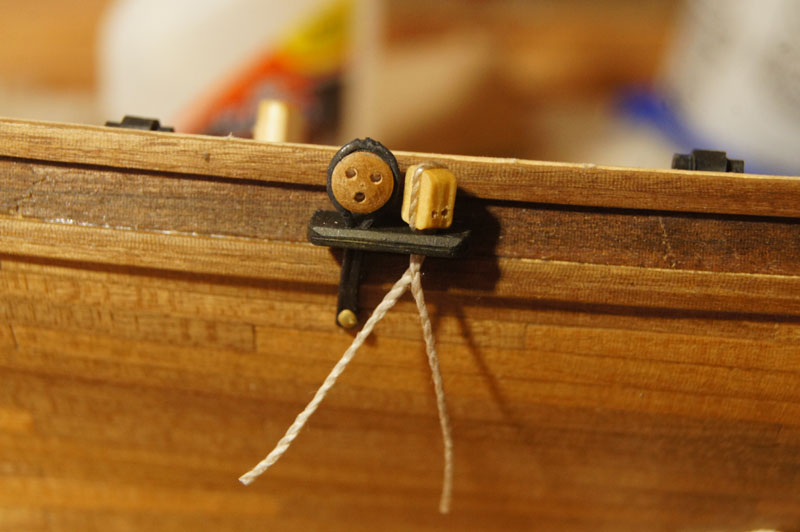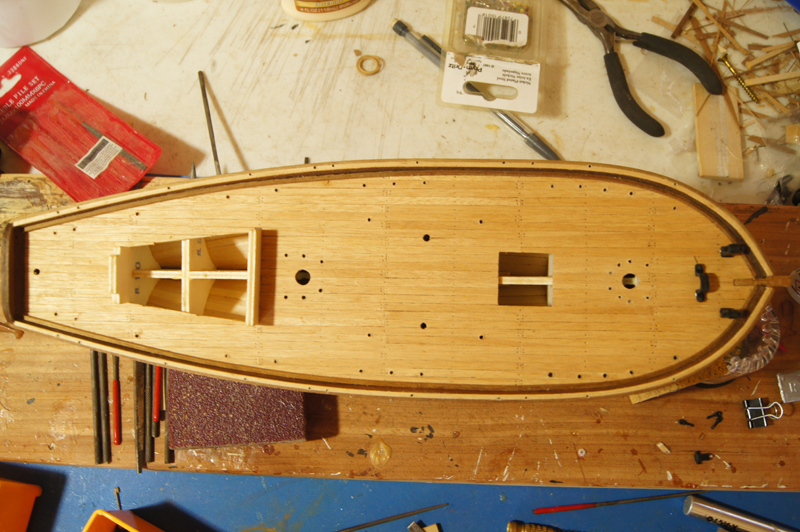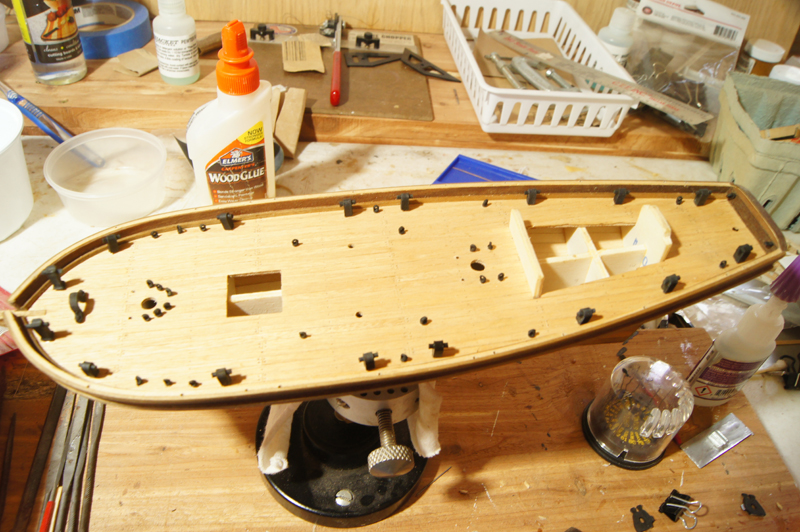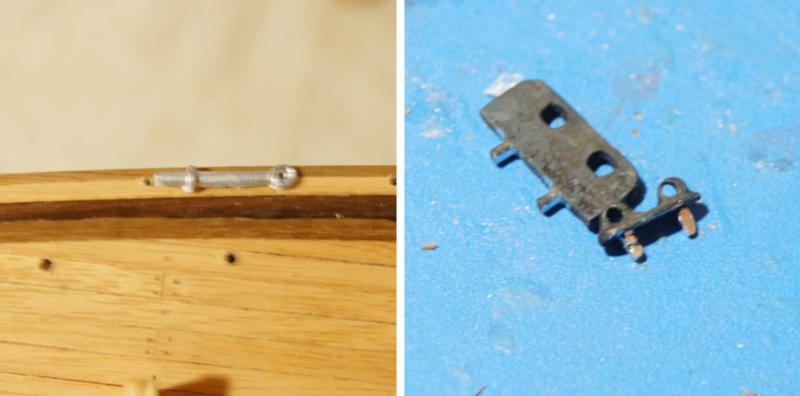-
Posts
3,378 -
Joined
-
Last visited
Content Type
Profiles
Forums
Gallery
Events
Everything posted by Cathead
-
Well, no worries, I've done my orders and now eagerly await better stuff to work with. In the meantime I have a busy work week and a spousal birthday on Saturday, so not much will likely get done soon anyway.
- 96 replies
-
- topsail schooner
- revenue cutter
-
(and 3 more)
Tagged with:
-
Thanks to both of you. It's too bad I already did the deck blocks, but I also tended to choose the best of the lot for that job, so even after re-inspection I think they'll serve. Or I suppose I could cut 'em off and try my hand at attaching new ones straight to the rings. Hmmm. Anyway, it's the support network and the presence of actual builders/sellers like Chuck and other small businesses on here that make this such a great place (and yes, my membership in NRG is up-to-date so I'm not just saying that!). While I wait for all this new stuff, I'll probably work on shaping the masts and rebuilding the cross-trees from scratch (another crappy metal piece I've given up on, and they should be wood anyway). Matt, is M-E's rigging line any good? I ask because I have an unused credit there and budget is always a concern for me. I'm definitely ordering blocks from Syren.
- 96 replies
-
- topsail schooner
- revenue cutter
-
(and 3 more)
Tagged with:
-
Well, would you look at that, now. I'd been all over the site but never thought to click on the actual blocks. Thank you, sir. Do you have an alert set up for your name or something? I thought of pming you but didn't want to waste your time with such a newbie question. An order will be forthcoming.
- 96 replies
-
- topsail schooner
- revenue cutter
-
(and 3 more)
Tagged with:
-
I'm facing a challenge, which I hope one of you more experienced sorts can advise me on. This kit has finally broken my desire to stick with the supplied materials. Both the blocks and belaying pins are near worthless, and the rigging line seems cheap. So I've decided to bite the bullet and order better stuff from Syren or an equivalent quality provider. But here's my dilemma: I don't know what size rigging line to order. Nowhere in the Corel instructions can I find a listing of the three line thicknesses they provide. And what really makes me paranoid is, I don't know how large the holes are in, say, the Syren blocks. So how do I determine what size line to buy, so that it's right and fits through good blocks? Any suggestions? I found the line-size chart on Syren's website, which is nice, but it doesn't help me determine what will fit properly in different blocks. Help a newbie, please!
- 96 replies
-
- topsail schooner
- revenue cutter
-
(and 3 more)
Tagged with:
-
The yellow stripe is very British; were American ships ever painted following that pattern? It looks nice but I wonder if it's at all authentic? Really nice rundown of color options and models.
- 362 replies
-
- active
- revenue cutter
-
(and 1 more)
Tagged with:
-
I think Bertrand was around 160 feet long, which at 1:87 comes out to a little over two feet. The decking looks nice so far; I'm a big fan of that varied, weathered look: whether or not it's more accurate, it tends to feel more realistic than a uniform painted finish. And, as you said, perfect for a fictitious boat anyway.
- 69 replies
-
- city of monroe
- steamboat
-
(and 1 more)
Tagged with:
-
She's a big beast, all right! Thanks for the update, I was wondering how you were coming along. Nice progress. What kind of wood are you using?
- 69 replies
-
- city of monroe
- steamboat
-
(and 1 more)
Tagged with:
-
Made some nice progress this weekend, lots of photos below. Matt, thanks for the kind words! You probably actually think I'm nuts for sticking with the kit materials, but it's an interesting challenge to my way of thinking. Plus, I don't have anywhere near the metal-working skills you do (yes, I know there's only one way to change that). It's too late on the rings, I already glued them in, so we'll just see how that goes. Also, I did use Cog's advice and knotted some small strips beneath the channel blocks; seems to have worked nicely. Building the cabin, you guessed it, involved overcoming flaws in the kit. First, the kit only provides fore and aft bulkheads to build the cabin around, with only very thin planking to wall it in. That seemed like a bad idea to me. So I added longitudinal bulkheads to provide a solid surface all the way round. The same problem exists for the roof, which again they expect you to plank in with no support. Uh uh. So I added some roof braces. Of course, the height of the shoulders on the kit-original bulkheads didn't match, so that the fore bulkhead was higher than the after bulkhead. So I sanded a camber into the fore bulkhead to accomodate this, figuring it was probably a realistic choice anyway. I also started adding windows and planking. After some trial and error I got the whole cabin built and planked. So little extra wood is given in this kit that I literally finished this with nothing to spare. I couldn't have afforded to break one single piece. I think it came out nicely, although one part of the roof planking is slightly cockeyed. It's only visible to the camera lens under harsh light, though. I like how the color balance came out, I wanted to cabin darker than the deck so it would stand out. Now for another kit problem. The pre-cast mounting ring for the carronade has two pegs underneath that are meant for holes in the deck. No problem, right? After all, those holes are pre-drilled in the plywood underdeck, so all you have to do is plank over them, file them open, and mount the ring. Yeah, no. I didn't think to pre-test the fit of the ring until now, and sure enough one of the holes was way off. One hole was right where it should be to mount the ring dead-center on the deck; the other was over a diameter too far outboard. I had to measure and drill a new mounting hole. Below left, you see the ring mounted properly, with the original factory-drilled hole in its horribly visible location. Below right, you see how I decided to handle this: I just filed a couple of wood scraps to look like some kind of step or brace against the ring. They'll vanish into the clutter of the deck once the model is complete, and only a serious naval historian would wonder what the heck they're for (and that person would already realize that this model is not museum-quality). Finally, I mounted the rudder. More CA glue leaked around the edges of the iron bands than I would have liked, under the right light there's some annoying glistening along the edges. But under most conditions it's not noticeable and I think the rudder looks nice overall. I also mounted the tiller. The kit-drilled tiller hole didn't come close to matching up with the angle of the rudder, so I just cut off the rudder post and shaped a new tiller post that I glued to the top of the deck instead. No one will ever now but you, gentle readers. I have to say, it's been really fun adding all the deck detail, this thing is starting to feel like a real ship build. I hadn't intended it to turn out as it has so far, but now I'm liking the shades of bare wood and the simple black iron fittings. I've given up on trying to match this to any specific plans or ship, it's evolved to just become a fun personal model. Thanks for reading.
- 96 replies
-
- topsail schooner
- revenue cutter
-
(and 3 more)
Tagged with:
-
So Heroine had no Texas or equivalent skylights for the main cabin? That's interesting; it must have been gloomy inside. Capstan, stove, and everything else look great. Glad you're feeling better.
-
How frustrating. I've certainly found that a clear head, after taking a break, can come up with a solution more easily than a frustrated head. Good luck.
- 245 replies
-
- model shipways
- Finished
-
(and 1 more)
Tagged with:
-
I've been working on rigging the first blocks to the deck fittings; I decided it would be better overall to do this before installing the rings. It's been easy to hold each ring in a clamp, tie the block on & glue it in place, then insert the ring into the deck. This way if I make a mistake it isn't already attached to the model. Below are the first six block/ring assemblies in place around the foremast's hole. These will be in tension vertically once rigged, so I don't care how they lay about for now. I also assembled and installed the channels, which led to an unresolved problem. Each channel has a regular deadeye attached to a chainplate, then a block that's supposed to be tied to the channel. See below. The problem is, the instructions just say to tie this block to the channel, and show what looks like some kind of small stopper knot beneath that would hold the block in place. But the hole in the channel is way too large for this; the size knot it would take to keep this block in place under tension would be almost as big as the block itself, and would look ridiculous. So my problem is, how do I fix this block in place? Do I somehow tie a small scrap of wood onto the line to act as a stopper? Do I try to CA the line to the underside of the channel? I've been having trouble searching for an answer to this on MSW and elsewhere, as the search terms are so vague. Any ideas?
- 96 replies
-
- topsail schooner
- revenue cutter
-
(and 3 more)
Tagged with:
-
Hey, Bruce, thanks for taking the time to write up your detailed observations. I don't know when or if I'll tackle a kit like this, but I learn just from reading others' work. It's appreciated. And, of course, nice work.
- 245 replies
-
- model shipways
- Finished
-
(and 1 more)
Tagged with:
-
I certainly had a load of trouble drilling those bands. I'm quite curious to see how you did yours.
- 335 replies
-
- 18th century longboat
- Finished
-
(and 1 more)
Tagged with:
-
It's a lovely little model, and very creative. Congratulations on finishing!
- 31 replies
-
- sloop
- sloop of war
-
(and 1 more)
Tagged with:
-
I have been working on the deck fittings.Below, you see the deck with all holes drilled for the metal fittings (rings, bits, etc.): And here you see most of the fittings test-placed (unglued) to get a sense of the deck's layout. Many of these will have small blocks; I'm trying to decide whether I should tie those in before gluing down the fittings, or afterward. Another source of annoyance in this kit: these metal fittings have "pins" meant to fit into the deck holes, but many of them are too thick or long. For example, the stanchions which will hold safety lines have pins nearly the width of the rails, as shown in the blurry photo below. I've drilled smaller pilots holes, but am reluctant to drill any wider for fear of splitting the rail. So I may have to file down all these tiny parts to fit proper holes. I've also had this problem with the plates and other hull fittings; their pins are so long that holes drilled in the rails would go right through. As it is, I've been desperately careful drilling pilot holes sideways through these rails without poking through. So I've been spending lots of time filing down the pins on these fittings to be narrower and pointier so I can drive them into the wood and have them hold more securely. It's been very fiddly work but I think it'll come out ok. As this is the first rigged ship I've ever attempted, I don't know if this kind of thing or normal, or unique to the Corel kit. Are there any thoughts on whether to pre-rig blocks to the rings, or do it after gluing the rings in? Anything else I should be considering at this stage?
- 96 replies
-
- topsail schooner
- revenue cutter
-
(and 3 more)
Tagged with:
-
For anyone in central Missouri, I will be displaying the Bertrand and several other models at the Tigercon 2016 model show in Columbia, Missouri tomorrow (Saturday November 5). I apologize for the very late warning, it somehow never occurred to me that it might be of interest to anyone here, but there are a few folks from Missouri on the forum so I thought I'd mention it.
-
Mike, you've done a fine job. I appreciate your build log, too, as it's helped me better understand a kit I may well want to build myself one day. One question, forgive me if I missed the answer earlier: did you treat the lines with anything to help keep them from sagging over time? Otherwise, hearty congratulations. I'll miss following along on this. I need to get moving on my current project so I can go back to another steamboat myself.
- 225 replies
-
- chaperon
- model shipways
-
(and 1 more)
Tagged with:
-
Kurt, I remember at some point you posting a great photo of a fire-bucket rack on a steamboat. Or was it someone else posted it, and you just explained it? Either way it was a really illustrative photo, if you know what I'm talking about and where to find it. Mike, I did something similar with the boats for Bertrand: I wasn't happy with hollow shells either, so added wooden thwarts, tillers, rudders, etc. I think both mine and yours gained a lot from the modifications.
- 225 replies
-
- chaperon
- model shipways
-
(and 1 more)
Tagged with:
-
Clarence, for whatever it's worth, that article lists the boat solely as the "Monroe" (not "City of"), and Way's Packet Directory also lists the "Monroe" as being a sternwheeler that operated on the Ouchita late in its life. Although, just to throw a little more fog into the mix, that online article claims that Ouchita-operating Monroe was built in Pittsburg (sic) while the Way's Monroe is listed as built in Wheeling. I think I'd trust the latter over the online article which may or may not know what it's talking about. I certainly don't think it affects your model's interest in any way, it'll be a really neat build no matter what. Given that Fryant himself lists his plans as being for a fictional boat, I'm not sure it's worth trying to tie them too strongly to any given prototype. As for the fuel, the Monroe in Way's was built 1886 and sank 1915, and certainly by the later end of that period I wouldn't be surprised if it had been converted to coal even if originally built for wood. Wood became a dear commodity along the rivers as the regions were deforested due to high demand, and coal was much more energy-dense (same reason railroads converted over). I don't think I can help you much on the small boats. My understanding was that most steamboats in the core riverboat era didn't carry "lifeboats" in the marine sense of the word, just a couple small yawls for general-purpose use. There was no direct provision for passenger safety. I don't know when/if that changed; I could see different practices developing as the 20th century got underway. I suspect Kurt or Captain Bob would know more.
- 69 replies
-
- city of monroe
- steamboat
-
(and 1 more)
Tagged with:
-
From Bob's link: That explains the discrepancy. This will be a neat project regardless, and I'm looking forward to it.
- 69 replies
-
- city of monroe
- steamboat
-
(and 1 more)
Tagged with:
-
I wonder if the Fryant plans are for one of the three "Monroe"s known to be built? One was a centerwheel ferry, one was a sidewheeler, but the third was a sternwheeler that operated on the Ouchita River, built in 1886. The photo in that link looks pretty similar to your plans.
- 69 replies
-
- city of monroe
- steamboat
-
(and 1 more)
Tagged with:
About us
Modelshipworld - Advancing Ship Modeling through Research
SSL Secured
Your security is important for us so this Website is SSL-Secured
NRG Mailing Address
Nautical Research Guild
237 South Lincoln Street
Westmont IL, 60559-1917
Model Ship World ® and the MSW logo are Registered Trademarks, and belong to the Nautical Research Guild (United States Patent and Trademark Office: No. 6,929,264 & No. 6,929,274, registered Dec. 20, 2022)
Helpful Links
About the NRG
If you enjoy building ship models that are historically accurate as well as beautiful, then The Nautical Research Guild (NRG) is just right for you.
The Guild is a non-profit educational organization whose mission is to “Advance Ship Modeling Through Research”. We provide support to our members in their efforts to raise the quality of their model ships.
The Nautical Research Guild has published our world-renowned quarterly magazine, The Nautical Research Journal, since 1955. The pages of the Journal are full of articles by accomplished ship modelers who show you how they create those exquisite details on their models, and by maritime historians who show you the correct details to build. The Journal is available in both print and digital editions. Go to the NRG web site (www.thenrg.org) to download a complimentary digital copy of the Journal. The NRG also publishes plan sets, books and compilations of back issues of the Journal and the former Ships in Scale and Model Ship Builder magazines.




